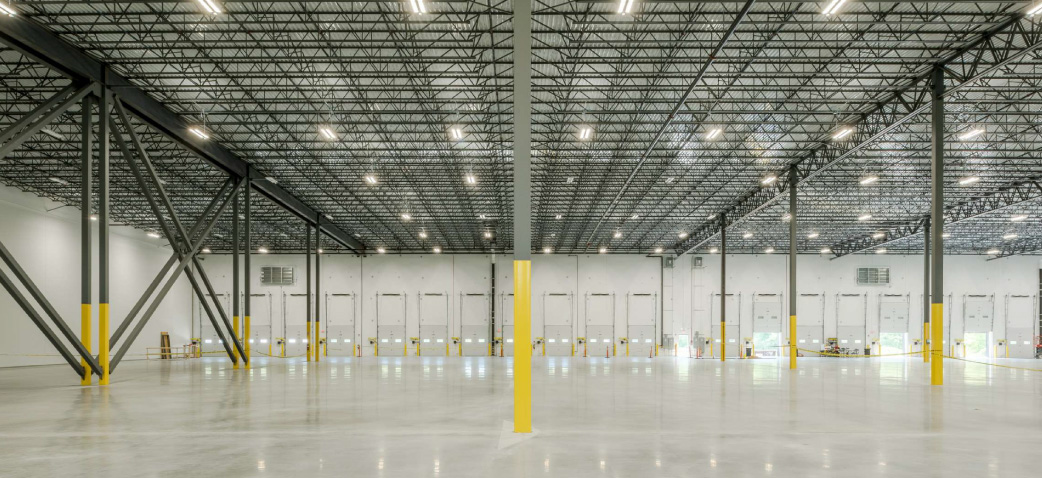Confused about your next industrial facility and its design for optimal efficiency? You are not alone. Today’s industrial real estate is experiencing a significant shift in the style and uses. But that’s not the only change impacting industrial development – the way in which industrial buildings are designed is also changing.
Before we talk about the design process, layout, floor space, equipment, flow and functionality, let us first look at some key points to consider:
- To facilitate locating a suitable property, seek help from a commercial broker and your architect.
- If your future facility will need heavy electrical demand, it may require up to 18 months or more to meet your power needs.
- Make a list of all needed spaces: office, breakrooms, conference room and rest rooms, among others.
- A 100,000-SF industrial building will need about 25 loading docks. Twenty years ago, 12 docks would have been enough.
- You'll need between 32-36 feet clear height as compared with 24-26 feet two decades ago. It is going to get higher and higher.
- Robots should also be taken into consideration.
- Most importantly, what is your budget? Have you explored your operating cost at the current facility versus a new location?
- Relocation to a new building may be expensive, but you will get modern mechanical and electrical systems, new technology, and a building built to latest codes and energy efficiency. On the other hand, aging facilities might lack the advantage of an optimal column layout, proper height, and cleaner energy solutions.
Now, coming back to design, most developers and users are looking for flexibility in industrial buildings. A flex building is designed to be easily customized to a client’s needs, whether that be office, warehouse, distribution, manufacturing or multi-tenant. The trend is to initially design the building to accommodate small office spaces before a tenant is landed but make it flexible enough to be enlarged once a tenant has been signed.
To ensure that a developer can attract the widest range of potential tenants, the design should consider multiple entrances, flexible ceiling heights and the ability to easily add a floor. Simply placing the entrance at the corner of the building, so it doesn’t get lost in the center, creates a more dramatic approach, and enables less expensive materials to be used around the back.
Tilt-up Panel Construction
We are also seeing a change in the types of materials used in industrial building design. In the past, warehouse buildings were constructed with metal panels, which were often damaged from fork lifts and other distribution activities. To combat the issue, there is a movement towards concrete tilt-up panel buildings. In tilt-up panel construction, the concrete contractor pours the walls within the building and then a crane is used to lift the walls in place. Tilt-ups are more durable, efficient, sustainable, and cost effective. They also require a much smaller carbon footprint than metal panels. The upfront cost of tilt-up panels is more expensive, but for the longevity of the building and the lower maintenance, it is, and will continue to be, the more economical option in the long run.
For clients that want a lower initial cost, another alternative is a hybrid of masonry and metal panel. Masonry is designed at the base of the building up to 12 feet with metal panel above. The hybrid option provides a durable barrier that protects against fork lift hits and 18-wheelers backing into the overhead doors. The initial cost of hybrid construction is cheaper, but masonry and the metal panel still needs to be replaced every 10 - 15 years, with fading making it hard to match.
Maximizing Column Bay Spacing
A major design consideration is the economics of steel and its impact on the column bay spacing, especially in distribution space. If you think about Amazon or Wayfair, a customer can purchase a pen or a couch – two very different sized items that need to be stored and accessed efficiently. The flexibility of a building’s racking system and its ability to handle a range of inventory is important. If you increase the building’s column bay spacing, you can increase the size of stored goods.
Warehouses typically have wider column bay spacing of 52 to 54 feet, as compared to office or flex buildings, which have spacing between 35 to 40 feet. The wider bays allow for more racking within the bay for storage and a better use of space. When steel is expensive, smaller column spacing is desired because it needs less steel support. The challenge is to find the sweet spot where you can expand column spacing and still have structural support that enables you to get a good rate of return.
Mike Kunz is a principal of Maugel DeStefano Architects and leads the firm's Industrial & Commercial Studio.
related content
Maugel DeStefano Architects Named 2023 Architectural Firm of the Year
Read Industrial News & Insights

